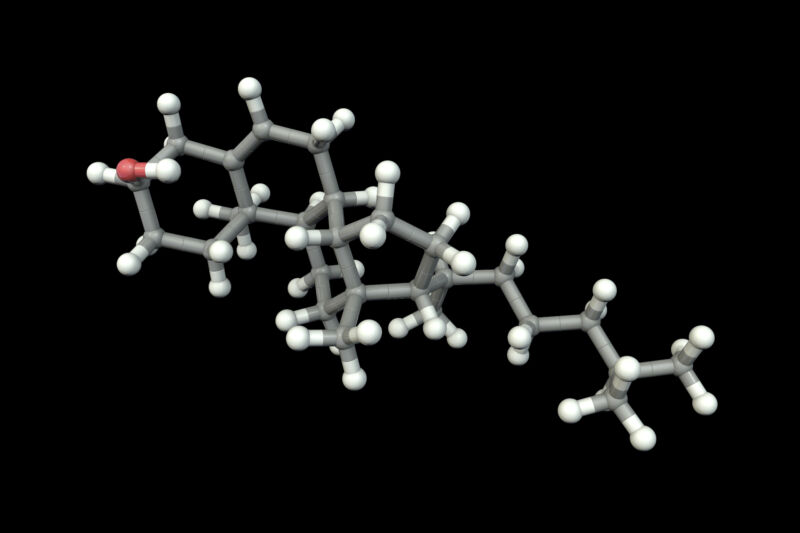
All the organisms that we can see around us – the plants, animals and fungi – are eukaryotes composed of complex cells. Their cells have many internal structures enclosed in membranes, which keep things like energy production separate from genetic material, and so on. Even the single-celled organisms on this branch of the tree of life often have membrane-covered structures that they move and rearrange to feed.
Part of that membrane flexibility is due to steroids. In multicellular eukaryotes, steroids perform several functions; they are used, among other things, as signaling molecules, such as estrogen and testosterone. But all eukaryotes introduce various steroids into their membranes, increasing their fluidity and changing their curvature. So the evolution of an extensive metabolism of steroids may have been critical to making complex life possible.
Now researchers have traced the origins of eukaryotic steroids back nearly a billion years. The results suggest that many branches of the eukaryotic family tree once made early versions of steroids. But our branch developed the ability to produce more elaborate ones – which may have helped us beat our relatives.
A confused timeline
To some extent, the new work involves testing an idea proposed decades ago by the biochemist Konrad Bloch. Bloch won a Nobel Prize for figuring out the biochemical pathways that allow cells to produce steroids from simpler precursors. In 1994, Bloch suggested that the chemical intermediates on the pathways he identified were, at some point in our evolutionary pathways, the final products. Cells would make these less complex steroids, which played a critical role in their survival; over time, however, our industry developed enzymes that further modified them in ways that were beneficial.
This had the potential to make sense of a variety of evidence that otherwise didn’t fit together very well. We have found microfossils as old as 1.6 billion years old that appear to show complex cells with surface processes typically restricted to eukaryotes. That works well with the DNA evidence, which suggests that all current eukaryotes can be traced back to a common ancestor that existed at least 1.2 billion years ago, perhaps as far back as 1.8 billion years ago.
But we can also look for steroids in ancient rock, because the molecules are remarkably stable. But the steroids in today’s eukaryotes don’t appear until about a billion years ago — much later than the eukaryotes themselves. That gap could be neatly explained if the earlier eukaryotes used Bloch’s biochemical intermediates.
It was here that Bloch, despite doing so much right, got one big thing wrong. He suggested that the intermediates would be chemically unstable and thus would not survive in sediments long enough for them to be found. In this view, there was no point in looking.
long-term
An international team of researchers decided it would be worth testing Bloch’s assumption about the robustness of these molecules. So the researchers synthesized a bunch and subjected the molecules to heating and accelerated aging and saw what happened. While they lost a few atoms on the side of the annular structures, most of the molecule survived. And, more importantly, no other steroids are known to produce the same molecules when broken down, so these aged intermediates can serve as tracers of steroid production.
With that information in hand, the researchers obtained oil and bitumen samples from sediments dating from different points in Earth’s past. And even the oldest sample, 1.6 billion years old, already had many of the remains of these steroid intermediates. The researchers isolated dozens of relatives of steroid intermediates, but found none of the molecules you would expect if modern steroids were present.
Eukaryotes also seem to have been everywhere. “These protosteroids were detected in deep and relatively shallow water environments, microbial mats and pelagic habitats, shales and carbonates, as well as marine and probably lacustrine basins,” the researchers write.
Again, the first signs of modern steroids do not appear until less than a billion years ago, suggesting that eukaryotes – both our ancestors and other branches of the evolutionary tree – thrived for nearly a billion years using molecules that are now merely chemical intermediates. Several classes of modern steroids are also slowly appearing in the geologic record, suggesting there was no burst of innovation.
Survive extremes
The researchers propose an intriguing idea that places the origin of modern eukaryotes within the geological record. Eukaryotes appear to have originated within a geologic time period called the “boring billion,” which ran from about 1.8 to 0.8 billion years ago. During this time, as the name implies, not much happened. For most of this time, geology saw Earth’s continental plates merge into a supercontinent, which helped support a seemingly stable climate. Life seems to have responded to the relative standstill by forming equally stable ecosystems that have endured for much of this time.
While the ancestor of all modern eukaryotes probably evolved during the dull billion, the lack of ecological disturbances may have made it difficult to find an unoccupied ecological niche. Given that challenge, the researchers suggest, the evolution of modern steroids might have given them the tolerances necessary to occupy more extreme environments, such as where cold or high temperatures prevailed or places like mud flats that periodically dried out. This could mean that modern steroids were being created, but only at levels that make their detection unlikely.
The dull billion ended with an increase in tectonic activity and global ice ages, which could have produced the microbial equivalent of mass extinctions. In the turbulent environment that followed, the ability to tolerate extreme environmental conditions allowed by modern steroids would have given our ancestors an edge, allowing them to force all other branches of the eukaryotic tree to extinction.
Nature, 2023. DOI: 10.1038/s41586-023-06170-w (About DOIs).

